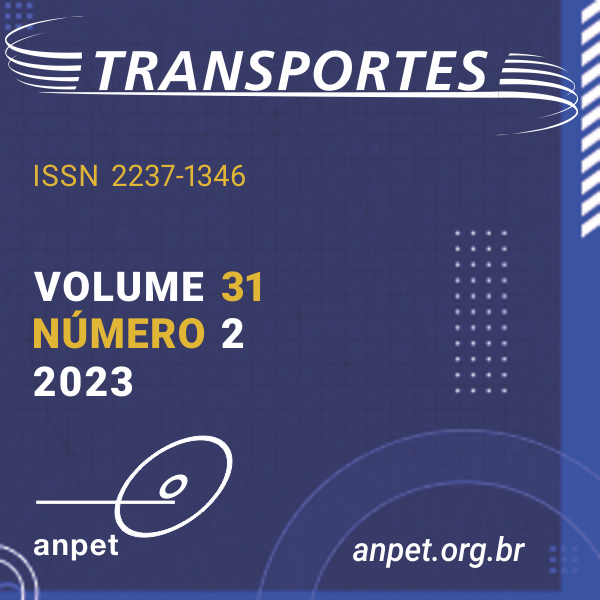Spatial relationship between sociodemographic and retail access data and e-commerce deliveries: the case of Belo Horizonte (Brazil)
DOI:
https://doi.org/10.58922/transportes.v31i2.2820Keywords:
e-commerce deliveries, urban freight transport, Spatial analysisAbstract
Many negative externalities are associated with home deliveries, the main ecommerce delivery destination. Despite many solutions that address this problem, the lack of understanding of the spatial pattern of urban deliveries makes it challenging to implement these strategies. This paper analyzed the spatial relationship between sociodemographic, retail and e-commerce deliveries in Belo Horizonte (Brazil) by using official data at the neighborhood level (number of retail shops, gender, income, age, race, and household size), and e-commerce deliveries performed by a transportation company. Global Moran's I indicated the spatial dependence of the e-commerce deliveries. Results of a geographically weighted regression model showed a positive spatial effect of retail, women, Asian population, age from 20 to 29 years old, and income. In addition, a negative spatial effect was identified for the size of the household, 18 to 19 years old, and the black population. Furthermore, the estimated coefficients show small spatial variability, indicating homogeneity in the spatial relation. The uniformity of the parameters indicates that alternative strategies can be implemented throughout the territory to reduce e-commerce deliveries.
Downloads
References
Beckers, J.; I. Cárdenas and A. Verhetsel (2018) Identifying the geography of online shopping adoption in Belgium. Journal of Retailing and Consumer Services, v. 45, p. 33-41. DOI: 10.1016/j.jretconser.2018.08.006. DOI: https://doi.org/10.1016/j.jretconser.2018.08.006
Beckers, J.; A. Verhetsel (2021) The sustainability of the urban layer of e-commerce deliveries: the Belgian collection and delivery point networks. European Planning Studies, v. 29, p. 2300-2319. DOI: 10.1080/09654313.2021.1921118. DOI: https://doi.org/10.1080/09654313.2021.1921118
Bivand, R.S.; E. Pebesma and V. Gomez-Rubio (2013) Applied Spatial Data Analysis with R. New York: Springer. DOI: 10.1007/978-1-4614-7618-4. DOI: https://doi.org/10.1007/978-1-4614-7618-4
Blasio, G. (2008) Urban-rural differences in internet usage, e-commerce, and e-banking: evidence from Italy. Growth and Change, v. 39, n. 2, p. 341-367. DOI: 10.1111/j.1468-2257.2008.00422.x. DOI: https://doi.org/10.1111/j.1468-2257.2008.00422.x
Cao, X.; Q. Chen and S. Choo (2013) Geographic distribution of e-shopping: application of structural equation models in the Twin Cities of Minnesota. Transportation Research Record, v. 2383, n. 1, p. 18-26. DOI: 10.3141/2383-03. DOI: https://doi.org/10.3141/2383-03
Cheng, C.; T. Sakai; A. Alho et al. (2021) Exploring the relationship between locational and household characteristics and e-commerce home delivery demand. Logistics, v. 5, n. 2, p. 29. DOI: 10.3390/logistics5020029. DOI: https://doi.org/10.3390/logistics5020029
Clarke, G.; C. Thompson and M. Birkin (2015) The emerging geography of e-commerce in British retailing. Regional Studies, Regional Science, v. 2, n. 1, p. 371-391. DOI: 10.1080/21681376.2015.1054420. DOI: https://doi.org/10.1080/21681376.2015.1054420
Eurostat (2022) E-commerce statistics for individuals. Available at: <https://ec.europa.eu/eurostat/statisticsexplained/index.php?title=E-commerce_statistics_for_individuals> (accessed 04/04/2023).
Farag, S.; M. Dijst and M. Lanzendorf (2003) Exploring the use of e-shopping and its impact on personal travel behavior in The Netherlands. Transportation Research Record, v. 1858, n. 1, p. 47-54. DOI: 10.3141/1858-07. DOI: https://doi.org/10.3141/1858-07
Farag, S.; T. Schwanen and M. Dijst (2005) Empirical investigation of online searching and buying and their relationship to shopping trips. Transportation Research Record, v. 1926, n. 1, p. 242-251. DOI: 10.1177/0361198105192600128. DOI: https://doi.org/10.1177/0361198105192600128
Farag, S.; T. Schwanen; M. Dijst et al. (2007) Shopping online and/or in-store? A structural equation model of the relationships between e-shopping and in-store shopping. Transportation Research Part A, Policy and Practice, v. 41, n. 2, p. 125-141. DOI: 10.1016/j.tra.2006.02.003. DOI: https://doi.org/10.1016/j.tra.2006.02.003
Farag, S.; K.J. Krizek and M. Dijst (2006a) E-shopping and its relationship with in-store shopping: empirical evidence from The Netherlands and the USA. Transport Reviews, v. 26, n. 1, p. 43-61. DOI: 10.1080/01441640500158496. DOI: https://doi.org/10.1080/01441640500158496
Farag, S.; J. Weltevreden; T. van Rietbergen et al. (2006b) E-shopping in the Netherlands: does geography matter?. Environment and Planning B: Planning and Design, v. 33, n. 1, p. 59-74. DOI: 10.1068/b31083. DOI: https://doi.org/10.1068/b31083
Fotheringham, A.S. and T.M. Oshan (2016) Geographically weighted regression and multicollinearity: dispelling the myth. Journal of Geographical Systems, v. 18, n. 4, p. 303-329. DOI: 10.1007/s10109-016-0239-5. DOI: https://doi.org/10.1007/s10109-016-0239-5
Fotheringham, A.S.; C. Brunsdon and M. Charlton (2002) Geographically Weighted Regression: The Analysis of Spatially Varying Relationships. West Sussex: John Wiley and Sons.
Fox, J. and S. Weisberg (2019) An R Companion to Applied Regression. Thousand Oaks: Sage.
Gollini, I.; B. Lu; M. Charlton et al. (2015) GWmodel: an R package for exploring spatial heterogeneity using geographically weighted models. Journal of Statistical Software, v. 63, n. 17, p. 1-50. DOI: 10.18637/jss.v063.i17. DOI: https://doi.org/10.18637/jss.v063.i17
Grekousis, G. (2020) Spatial Analysis Methods and Practice: Describe – Explore – Explain through GIS. Cambridge: Cambridge University Press. DOI: 10.1017/9781108614528. DOI: https://doi.org/10.1017/9781108614528
Hair, J.F.; W.C. Black; B.J. Babin et al. (2019) Multivariate Data Analysis. Hampshire: Cengage.
Hood, N.; R. Urquhart; A. Newing et al. (2020) Sociodemographic and spatial disaggregation of e-commerce channel use in the grocery market in Great Britain. Journal of Retailing and Consumer Services, v. 55, p. 102076. DOI: 10.1016/j.jretconser.2020.102076. DOI: https://doi.org/10.1016/j.jretconser.2020.102076
IBGE (2020) IBGE Cidades –Belo Horizonte. Available at: <https://cidades.ibge.gov.br/brasil/mg/belo-horizonte/panorama> (accessed 06/22/2023).
Jaller, M. and A. Pahwa (2020) Evaluating the environmental impacts of online shopping: a behavioral and transportation approach. Transportation Research Part D, Transport and Environment, v. 80, p. 102223. DOI: 10.1016/j.trd.2020.102223. DOI: https://doi.org/10.1016/j.trd.2020.102223
James, G; D. Witten; T. Hastie et al.(2015) An Introduction to Statistical Learning: With Applications in R. New York: Springer.
Jongen, W. (2018) The End of Online Shopping: The Future of Retail in an Always Connected World. New Jersey: World Scientific Publishing Company. DOI: 10.1142/11106. DOI: https://doi.org/10.1142/11106
Kirby-Hawkins, E.; M. Birkin and G. Clarke (2019) An investigation into the geography of corporate e-commerce sales in the UK grocery market. Environment and Planning. B, Urban Analytics and City Science, v. 46, n. 6, p. 1148-1164. DOI: 10.1177/2399808318755147. DOI: https://doi.org/10.1177/2399808318755147
Krizek, K.J.; Y. Li and S.L. Handy (2005) Spatial attributes and patterns of use in household-related information and communications technology activity. Transportation Research Record, v. 1926, n. 1, p. 252-259. DOI: 10.1177/0361198105192600129. DOI: https://doi.org/10.1177/0361198105192600129
Lee, R.J.; I.N. Sener and S.L. Handy (2015) Picture of online shoppers: specific focus on Davis, California. Transportation Research Record, v. 2496, n. 1, p. 55-63. DOI: 10.3141/2496-07. DOI: https://doi.org/10.3141/2496-07
Lee, R.J.; I.N. Sener; P.L. Mokhtarian et al. (2017) Relationships between the online and in-store shopping frequency of Davis, California residents. Transportation Research Part A, Policy and Practice, v. 100, p. 40-52. DOI: 10.1016/j.tra.2017.03.001. DOI: https://doi.org/10.1016/j.tra.2017.03.001
Loo, B.P.Y. and B. Wang (2018) Factors associated with home-based e-working and e-shopping in Nanjing, China. Transportation, v. 45, n. 2, p. 365-384. DOI: 10.1007/s11116-017-9792-0. DOI: https://doi.org/10.1007/s11116-017-9792-0
Lu, B.; M. Charlton; P. Harris et al. (2014) Geographically weighted regression with a non-Euclidean distance metric: a case study using hedonic house price data. International Journal of Geographical Information Science, v. 28, n. 4, p. 660-691. DOI: 10.1080/13658816.2013.865739. DOI: https://doi.org/10.1080/13658816.2013.865739
Moran, P.A.P. (1950) Notes on continuous stochastic phenomena. Biometrika, v. 37, n. 1-2, p. 17-23. DOI: 10.1093/biomet/37.1-2.17. PMid:15420245. DOI: https://doi.org/10.1093/biomet/37.1-2.17
Motte-Baumvol, B.; L. Belton-Chevallier; L. Dablanc et al. (2017) Spatial dimensions of e-shopping in France. Asian Transport Studies, v. 4, n. 3, p. 585-600. DOI: 10.11175/eastsats.4.585.
Nielsen (2022) Webshoppers. Available at: <https://nielseniq.com/global/pt/landing-page/ebit/nielseniq-ebitbrasil/webshoppers/> (accessed 04/04/2023).
OECD (2020) E-commerce in the time of COVID-19. Available at: <https://www.oecd.org/coronavirus/policyresponses/e-commerce-in-the-time-of-covid-19-3a2b78e8/> (accessed 04/04/2023).
Rai, H.B.; S. Verlinde and C. Macharis (2019) The “next day, free delivery” myth unravelled. International Journal of Retail & Distribution Management, v. 47, n. 1, p. 39-54. DOI: 10.1108/IJRDM-06-2018-0104. DOI: https://doi.org/10.1108/IJRDM-06-2018-0104
Ren, F. and M.-P. Kwan (2009) The impact of geographic context on e-shopping behavior. Environment and Planning B: Urban Analytics and City Science, v. 36, n. 2, p. 262-278. DOI: 10.1068/b34014t. DOI: https://doi.org/10.1068/b34014t
Saphores, J.-D. and L. Xu (2021) E-shopping changes and the state of e-grocery shopping in the US-evidence from national travel and time use surveys. Research in Transportation Economics, v. 87, p. 100864. DOI: 10.1016/j.retrec.2020.100864. DOI: https://doi.org/10.1016/j.retrec.2020.100864
Sener, I.N. and P.R. Reeder (2012) An examination of behavioral linkages across ICT choice dimensions: copula modeling of telecommuting and teleshopping choice behavior. Environment and Planning A: Economy and Space, v. 44, n. 6, p. 1459-1478. DOI: 10.1068/a44436. DOI: https://doi.org/10.1068/a44436
Silveira, L.S. and S.N. Leão (2020) O impacto da segregação ocupacional por gênero e raça na desigualdade de renda no Brasil em três décadas (1986-2015). Revista Latinoamericana de Población, v. 14, n. 27, p. 41-76. DOI: 10.31406/relap2020.v14.i12.n27.2. DOI: https://doi.org/10.31406/relap2020.v14.i12.n27.2
Song, Z. (2021) The geography of online shopping in China and its key drivers. Environment and Planning. B, Urban Analytics and City Science, v. 49, n. 1, p. 259-274. DOI: 10.1177/23998083211002189. DOI: https://doi.org/10.1177/23998083211002189
Statista (2021) Distribution of digital buyers in the United States as of February 2020, by age group. Available at: <https://www.statista.com/statistics/469184/us-digital-buyer-share-age-group/> (accessed 04/04/2023).
Statista (2022) Distribution of digital buyers in Brazil in 2022, by age group. Available at: <https://www.statista.com/statistics/519746/age-distribution-of-online-shoppers-in-brazil/> (accessed 04/04/2023).
UNCTAD (2021a) COVID-19 and E-commerce: a Global Review. New York: United Nations. Available at: <https://unctad.org/system/files/official-document/dtlstict2020d13_en_0.pdf> (accessed 04/04/2023).
UNCTAD (2021b) Estimates of Global E-commerce 2019 and Preliminary Assessment of COVID-19 Impac on Online Retail 2020. UNCTAD Technical Notes on ICT for Developmen Nº 118. New York: United Nations. Available at: <https://unctad.org/system/files/official-document/tn_unctad_ict4d18_en.pdf> (accessed 04/04/2023).
Zhou, Y. and X.C. Wang (2014) Explore the relationship between online shopping and shopping trips: an analysis with the 2009 NHTS data. Transportation Research Part A: Policy and Practice, v. 70, p. 1-9. DOI: 10.1016/j.tra.2014.09.014 DOI: https://doi.org/10.1016/j.tra.2014.09.014
Downloads
Published
How to Cite
Issue
Section
License
Copyright (c) 2023 Luísa Tavares Muzzi de Sousa, Isabela Kopperschmidt de Oliveira, Leise Kelli de Oliveira, Jorge Luiz dos Santos Junior, Bruno Vieira Bertoncini

This work is licensed under a Creative Commons Attribution 4.0 International License.
Authors who submit papers for publication by TRANSPORTES agree to the following terms:
- The authors retain the copyright and grant Transportes the right of first publication of the manuscript, without any financial charge, and waive any other remuneration for its publication by ANPET.
- Upon publication by Transportes, the manuscript is automatically licensed under the Creative Commons License CC BY 4.0 license. This license permits the work to be shared with proper attribution to the authors and its original publication in this journal, and to be adapted for non-commercial purposes, provided appropriate credit is given and any derivative works are distributed under the same terms.
- Authors are authorized to enter into additional separate contracts for the non-exclusive distribution of the version of the manuscript published in this journal (e.g., publishing in an institutional repository or as a book chapter), with recognition of the initial publication in this journal, provided that such a contract does not imply an endorsement of the content of the manuscript or the new medium by ANPET.
- Authors are permitted and encouraged to publish and distribute their work online (e.g., in institutional repositories or on their personal websites) after the editorial process is complete. As Transportes provides open access to all published issues, authors are encouraged to use links to the DOI of their article in these cases.
- Authors guarantee that they have obtained the necessary authorization from their employers for the transfer of rights under this agreement, if these employers hold any copyright over the manuscript. Additionally, authors assume all responsibility for any copyright infringements by these employers, releasing ANPET and Transportes from any responsibility in this regard.
- Authors assume full responsibility for the content of the manuscript, including the necessary and appropriate authorizations for the disclosure of collected data and obtained results, releasing ANPET and Transportes from any responsibility in this regard.









